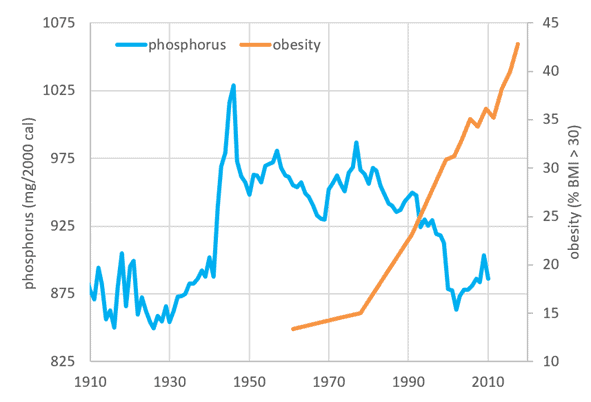Phosphorus, often overshadowed by its more famous counterparts, is the unsung hero of your body’s essential elements. It’s the second-most abundant inorganic element within you, tirelessly working behind the scenes to keep your health in check. From fortifying your bones and teeth to fuelling your body’s energy factories, phosphorus is the unsung star of human well-being.
In this captivating journey, we’ll unveil the remarkable world of phosphorus and its pivotal role in your health. We’ll explore which foods are rich in this essential mineral, presenting you with a vivid food high in phosphorus chart to guide your choices.
Join us as we delve into the depths of phosphorus-rich foods, uncover the secrets of maintaining optimal health, and understand how to make phosphorus work its magic for you.
- High Phosphorus Foods (Per Serving)
- Phosphorus-Rich Foods (Per Calorie)
- Phosphorus-Rich Foods Chart
- How Much Phosphorus Do You Need?
- Phosphorus-Rich Recipes
- Why is Phosphorus Important for Your Health?
- The Role of Phosphorus in the Human Body
- Symptoms of Inadequate or Excessive Phosphorus Intake
- Do You Need More Phosphorus in Your Diet?
- Availability of Phosphorus in the Food System
- Synergistic Nutrients That Work with Phosphorus
- How Can I Calculate if I’m Getting Enough Phosphorus?
High Phosphorus Foods (Per Serving)
If you find yourself falling short of the recommended phosphorus intake, it’s time to focus on foods that pack in more phosphorus per serving.
To help you get started, the infographic below shows the phosphorus provided by popular foods in the average serving sizes consumed by our Optimisers.
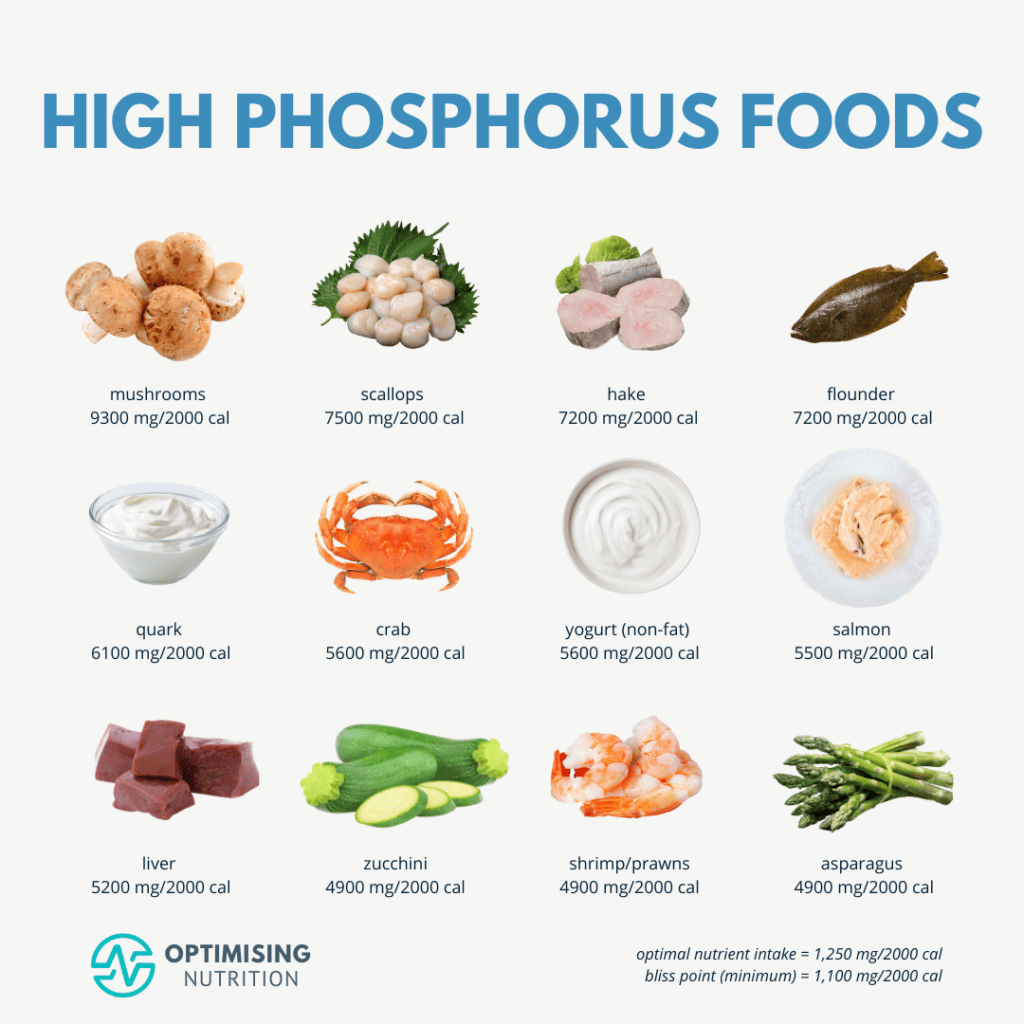
Once you’re ready to revitalise your diet with a wider variety of high-phosphorus foods, download our printable list of foods with more phosphorus per serving here.
Phosphorus-Rich Foods (Per Calorie)
Once you know you’re getting the minimum amount of phosphorus your body needs, you can zero in on foods that deliver more phosphorus per calorie to increase your satiety and nutrient density. The infographic below shows popular foods that provide more phosphorus per calorie.
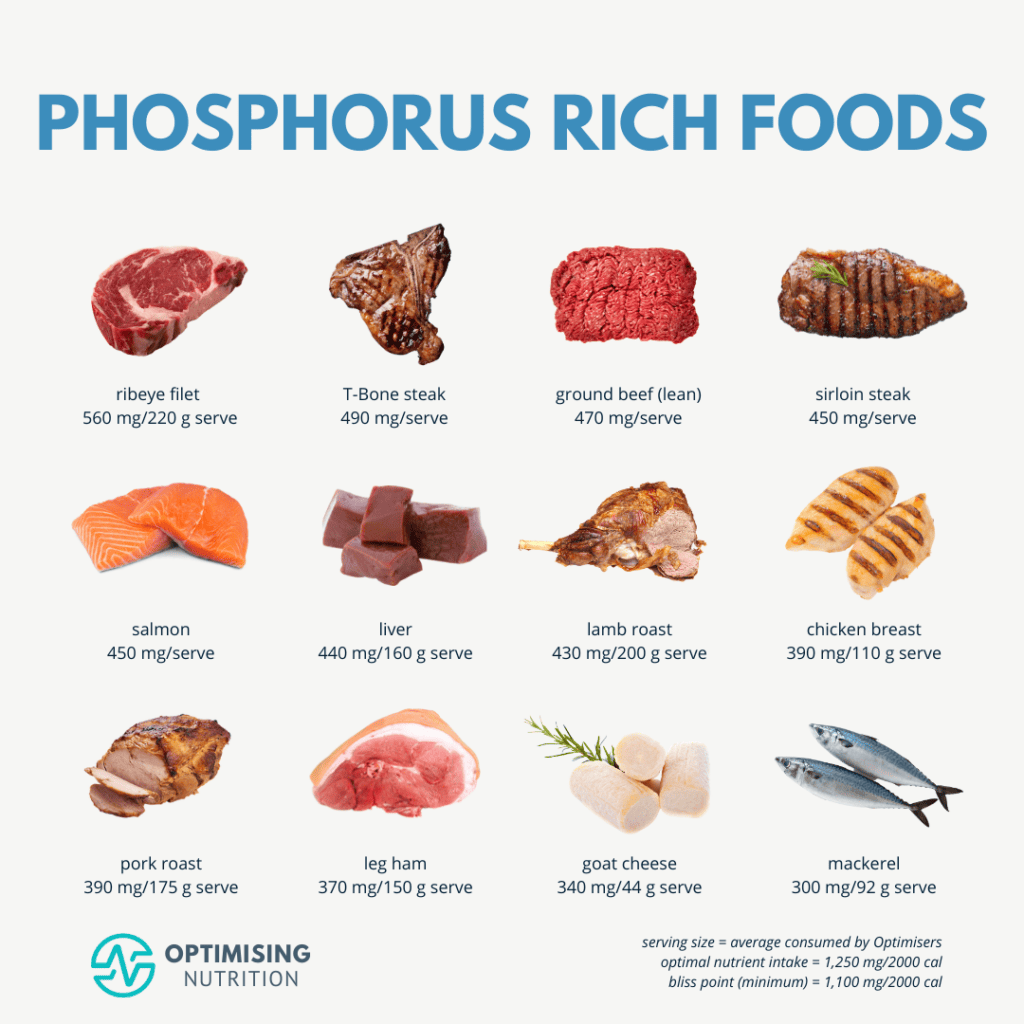
For more variety, check out our printable list of phosphorus-rich foods per calorie.
For those on vegan and vegetarian diets, beans, legumes, nuts, and seeds contain higher phosphorus than other plant foods like vegetables and fruits. However, these high amounts of phosphorus are often in the form of phytates that contribute to poor nutrient absorption.
It’s, therefore, essential to take proper precautions when eating these foods to lessen their phytate content so you get all the phosphorus you can. Soaking and sprouting have been shown to reduce phytate levels significantly.
Phosphorus-Rich Foods Chart
Curious about how your favourite foods stack up in the phosphorus game? Dive into our dynamic chart showcasing popular foods, comparing phosphorus content per calorie and per serving. For an immersive experience, explore the interactive Tableau version (on your computer).
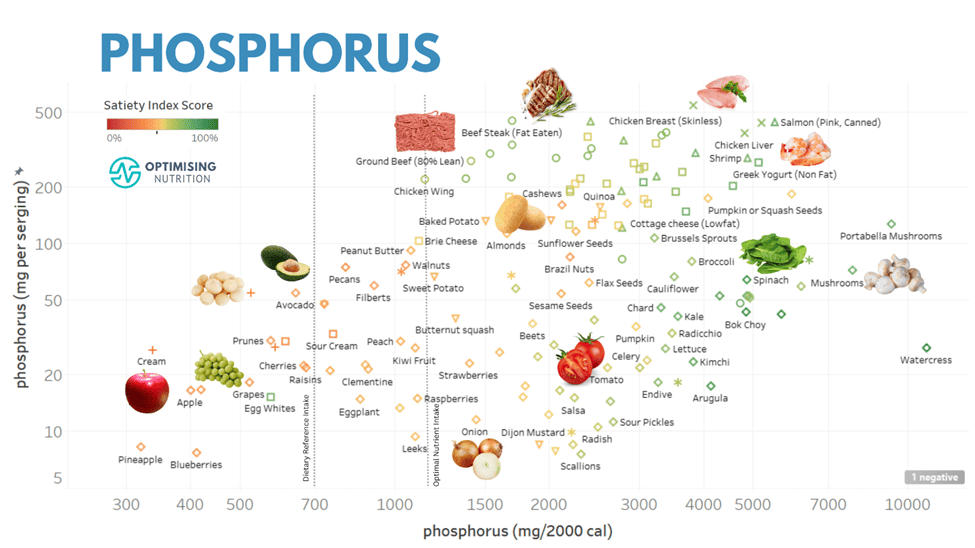
How Much Phosphorus Do You Need?
Our satiety analysis reveals that your body craves at least 1100 mg of phosphorus per 2000 calories, which is more than the Dietary Reference Intake of 700 mg for men.
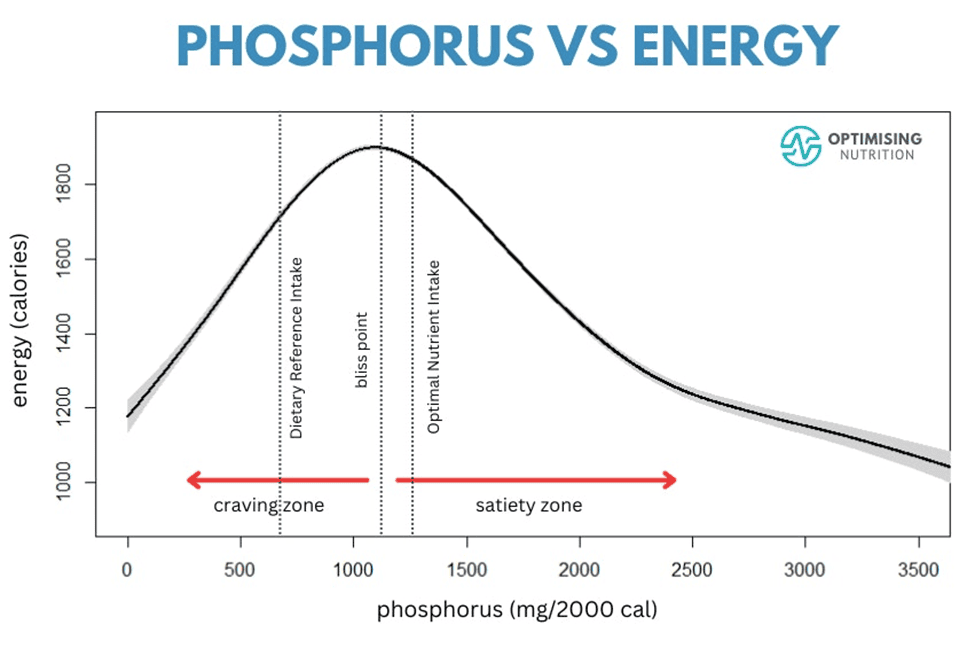
Phosphorus-Rich Recipes
Elevate your culinary game with our chart, showcasing over 1400 NutriBooster recipes used in our Micros Masterclass. We’ve plotted these recipes based on phosphorus content versus protein percentage. The further right you go, the more phosphorus you can enjoy with fewer calories. Notice that phosphorus and protein are correlated, so if you’re getting adequate protein, you’ll also be getting plenty of phosphorus.
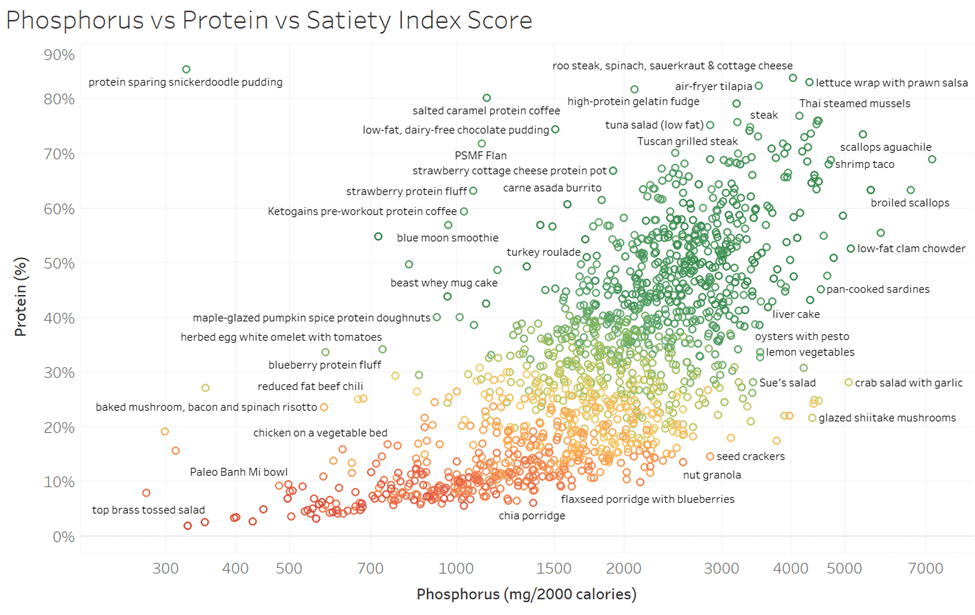
Dive into the details with our interactive Tableau chart on your computer. Click on each recipe to uncover the magic behind it and even feast your eyes on mouthwatering pictures!

Why is Phosphorus Important for Your Health?
Getting adequate phosphorus from your diet is important for a range of functions, including:
- Bone and teeth health: Phosphorus is a key component of bones and teeth. It helps to provide strength and structure to these tissues and also helps to regulate the balance of other minerals in the body, such as calcium.
- Energy metabolism: Phosphorus is necessary for the production and storage of energy in the body. It is a component of ATP (adenosine triphosphate), which is the primary energy currency of the body.
- Cell function: Phosphorus is involved in many cellular processes, including the synthesis of DNA and RNA, cell signalling, and membrane transport.
- Kidney function: Phosphorus levels in the blood are regulated by the kidneys. Proper phosphorus balance is important for kidney function and overall health.
- Nervous system function: Phosphorus is involved in the functioning of the nervous system. It helps to regulate the electrical activity of nerve cells and is involved in the synthesis of neurotransmitters.
The Role of Phosphorus in the Human Body
You require dietary phosphorus to:
- keep your bones strong and healthy,
- help your cells produce and store energy,
- move your muscles,
- build strong teeth,
- enable your kidneys to filter waste,
- create DNA and RNA (the body’s genetic building blocks),
- utilise vitamins B and D and minerals like iodine, magnesium, and zinc,
- grow, maintain, and repair tissues and cells,
- maintain a regular heartbeat,
- facilitate nerve conduction,
- Allow your body to utilise carbohydrates and fats properly,
- create adenosine triphosphate (ATP),
- maintain the acid-base balance (pH) in your blood, and
- support muscle recovery after exercise.
Symptoms of Inadequate or Excessive Phosphorus Intake
High phosphate can result from deficiencies in other nutrients that work alongside phosphate, like calcium. Phosphorus levels that are too high (hyperphosphatemia) or too low (hypophosphatemia) can cause medical complications that result in well-known conditions like heart disease, joint pain, or fatigue.
Aside from the symptoms listed above, hyperphosphatemia can appear with:
- muscle cramps and spasms,
- mouth numbness and tingling,
- weak bones,
- rash,
- itchy skin,
- water retention, and
- low energy.
Other symptoms of low phosphorus intake can include:
- anorexia,
- anaemia,
- muscle weakness,
- bone pain,
- rickets,
- osteomalacia,
- increased susceptibility to infection,
- paresthesias,
- ataxia,
- confusion, and
- death.
Low phosphorus can result from poor lifestyle and dietary habits that push someone to eat a low-protein, processed, carb-rich diet. Dysfunctions of the small intestine can also affect phosphorus absorption. For this reason, low phosphate is more common than high phosphate.
Do You Need More Phosphorus in Your Diet?
Because of the roles of phosphate in the body, you may require more phosphorus if you:
- drink a lot of coffee,
- have diabetes,
- are sensitive to gluten,
- consume excess calcium,
- abuse antacids,
- have poor digestion,
- are pregnant,
- consume minimal amounts of protein,
- consume a Standard American Diet (SAD),
- are lactating or
- have renal tubular dysfunction.
Availability of Phosphorus in the Food System
Since the introduction of synthetic fertilisers in the 1940s, the content of phosphorus in food has been on the decline, while obesity rates have steadily increased (data from USDA Economic Research Service). These fertilisers help crops grow more quickly, leading to fewer nutrients making their way into the crop. As a result, soils also become depleted for future harvests.
Synergistic Nutrients That Work with Phosphorus
While it’s essential to consider calcium when consuming phosphorus because they are synergists, this isn’t the only relationship important to phosphorus. Aside from calcium, phosphorus works synergically with vitamin B6, vitamin D, magnesium, and sodium. As a result, it is crucial to get your phosphorus from whole food sources that naturally come packaged with other necessary nutrients instead of relying on supplements.
How Can I Calculate if I’m Getting Enough Phosphorus?
Curious about your phosphorus intake? Take our Free 7-Day Nutrient Clarity Challenge and discover if you’re hitting the phosphorus sweet spot in your diet.
After just one week of tracking your daily meals with Cronometer, Nutrient Optimiser will unveil a personalised roadmap, your guide to a healthier, more nutrient-rich lifestyle.
You’ll receive a curated list of foods and tantalising NutriBooster recipes that not only fill your magnesium gaps but also ensure you’re not missing out on critical nutrients.
Ready to unlock your nutrient potential? Join the challenge and embark on a journey towards a brighter, healthier you!
Nutrient Density Starter Pack
Ready to supercharge your nutrition? Get our Nutrient Density Starter Pack – your all-access pass to a healthier, more vibrant you!
In our quest to make Nutritional Optimization a breeze, we’re thrilled to offer you this treasure trove of tools and resources when you join our vibrant Optimising Nutrition Community:
- Food Lists: Discover our carefully crafted lists optimised for each essential nutrient, tailored to your goals, preferences, and unique conditions.
- The Healthiest Meal Plan in the World: Peek into a week of mouthwatering, nutrient-dense meals that’ll leave you satisfied and energised.
- Recipes: Download delectable samples from our NutriBooster recipe books, designed to elevate your nutrition while tantalising your taste buds.
- 7-Day Nutrient Clarity Challenge: Unearth your priority nutrients and pinpoint the foods and meals that pack a nutrient punch so you can kickstart your journey to better health.
Don’t miss out on this incredible opportunity to transform your nutrition effortlessly. Join our community and unlock your path to a healthier, more vibrant you!
Nutrient Series
Minerals
- Calcium
- Iron
- Magnesium
- Phosphorus
- Potassium
- Sodium
- Zinc
- Selenium
- Copper
- Manganese
- Chromium
- Molybdenum
- Biotin (B7)
- Iodine
Vitamins
- Vitamin A
- Vitamin E
- Thiamine (B1)
- Riboflavin (B2)
- Niacin (B3)
- Pantothenic acid (B5)
- Vitamin B6
- Folate (B9)
- Vitamin B12
- Vitamin C
- Vitamin D
- Choline
- Vitamin K1
- Vitamin K2

